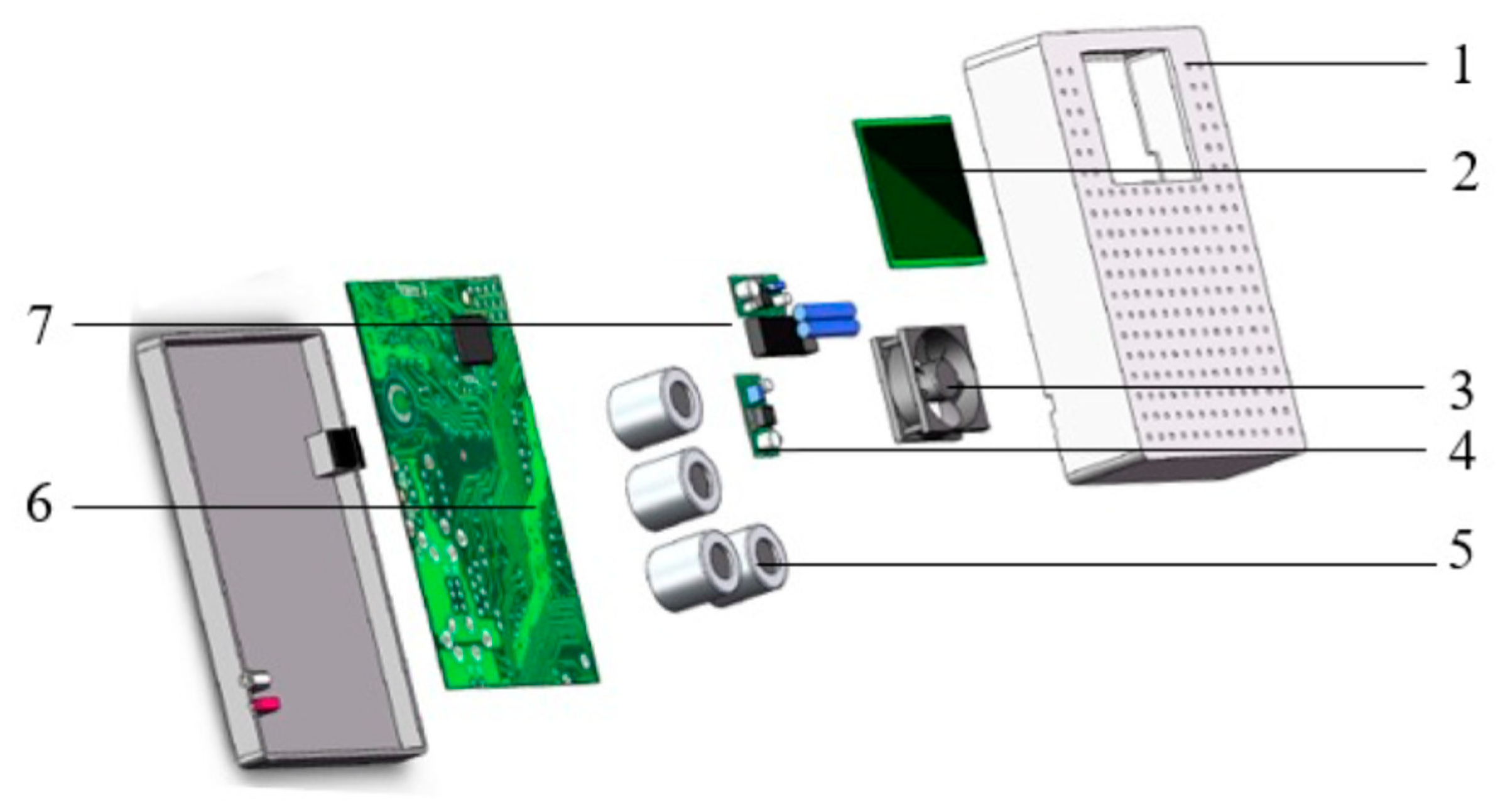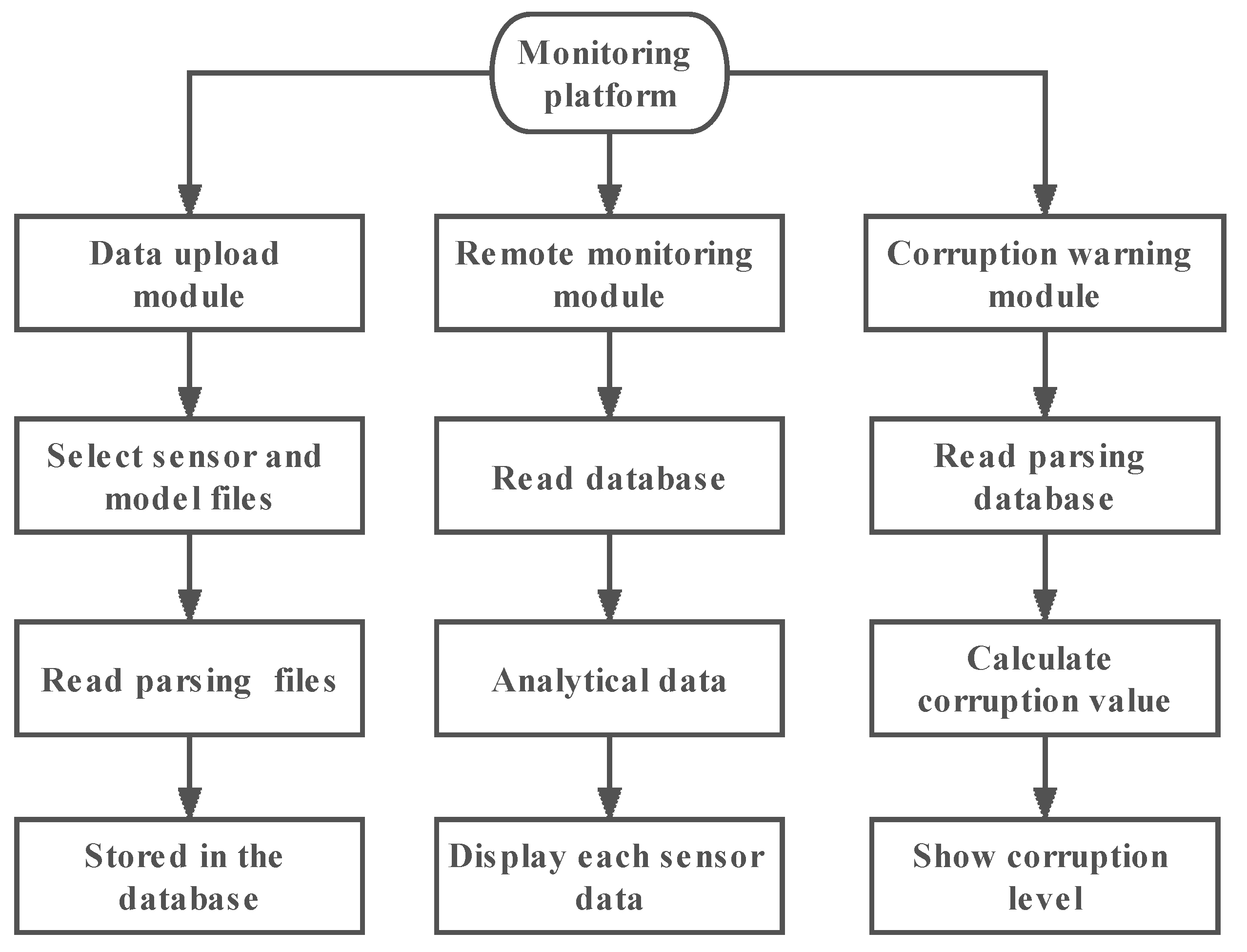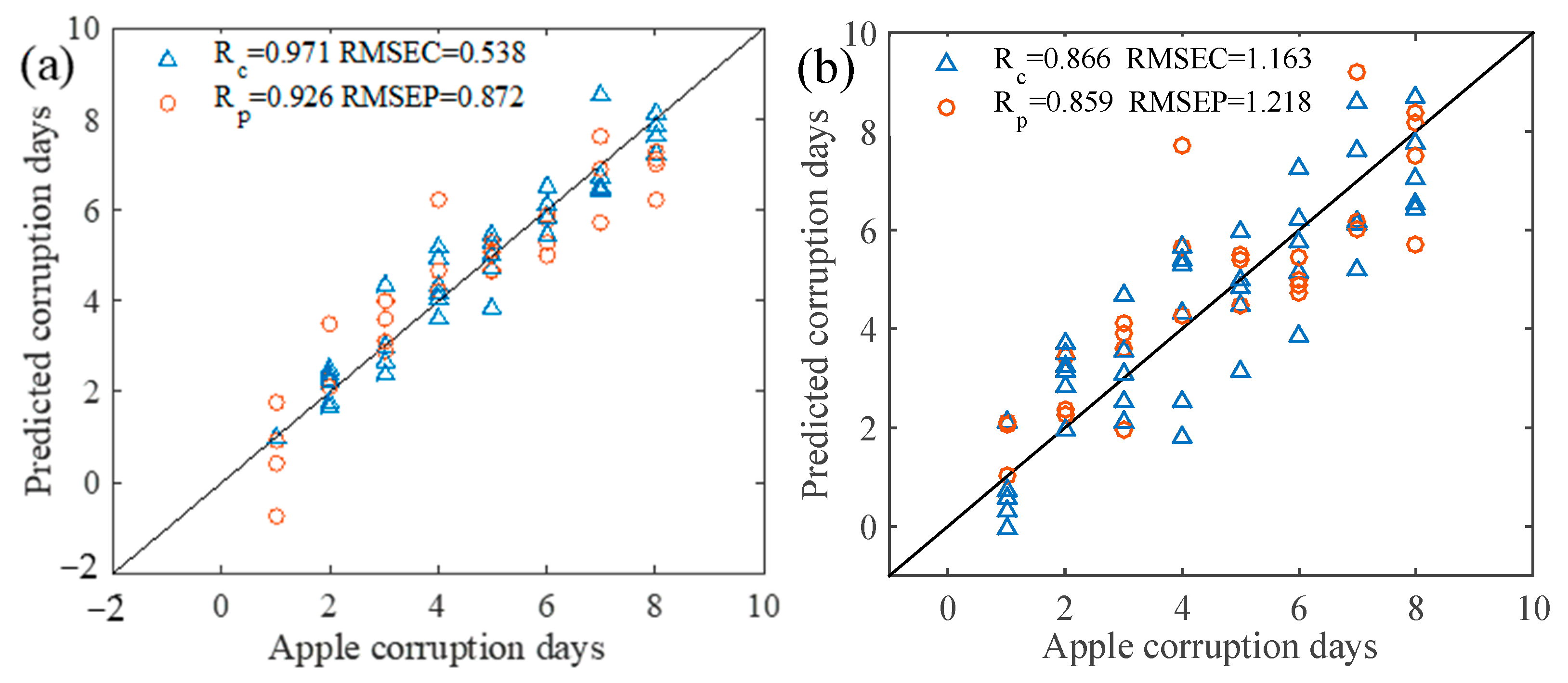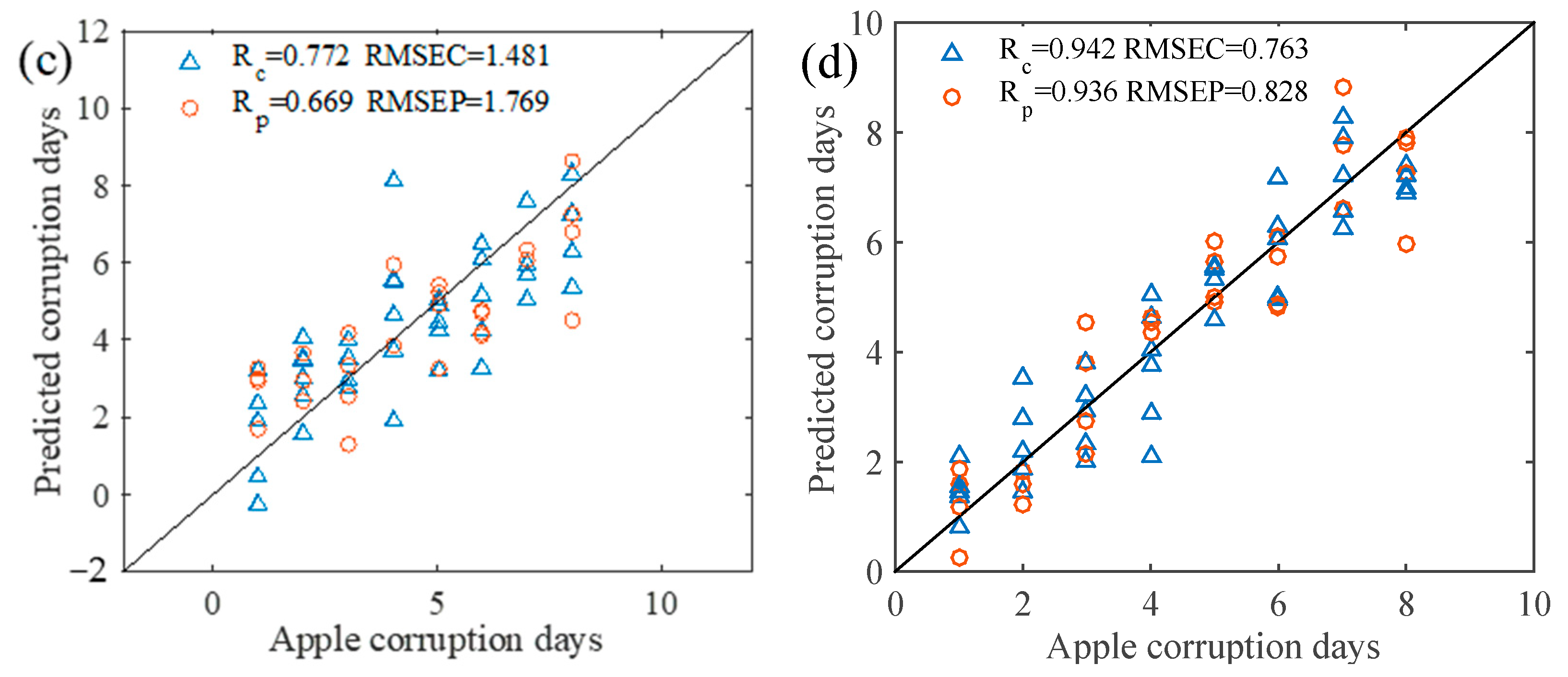Spoilage Monitoring and Early Warning for Apples in Storage Using Gas Sensors and Chemometrics
Abstract
:1. Introduction
2. Materials and Methods
2.1. Design of Monitoring Prototype
2.1.1. Selection and Optimization of Sensors
2.1.2. Air Chamber and Air Path Design
2.1.3. Hardware System Integration
2.1.4. Software Structure Design
2.1.5. Prototype System Integration
2.2. Apple Sample Preparation
2.2.1. Activated Culture and Inoculation of Spoilage Fungi
2.2.2. Micro-Environment Information Sensing
2.3. Variable Selection Method
2.3.1. Genetic Algorithm
2.3.2. Simulated Annealing Algorithm
2.3.3. Ant Colony Optimization Algorithm
2.3.4. Competitive Adaptive Reweighed Sampling
2.4. Apple Remote Monitoring and Early Warning Platform
3. Results
3.1. Analysis of Apple Volatile Gas
3.2. Apple Spoilage Early Warning Model
3.2.1. ACO-PLS Prediction Model of Apple Spoilage
3.2.2. CARS-PLS Prediction Model of Apple Spoilage
3.2.3. GA-PLS Prediction Model of Apple Spoilage
3.2.4. SA-PLS Prediction Model of Apple Spoilage
3.3. Comparison and Analysis of Various Models
4. Discussion
5. Conclusions
Author Contributions
Funding
Institutional Review Board Statement
Informed Consent Statement
Data Availability Statement
Conflicts of Interest
References
- Butkeviciute, A.; Viskelis, J.; Liaudanskas, M.; Viskelis, P.; Janulis, V. Impact of Storage Controlled Atmosphere on the Apple Phenolic Acids, Flavonoids, and Anthocyanins and Antioxidant Activity In Vitro. Plants 2022, 11, 201. [Google Scholar] [CrossRef] [PubMed]
- Shen, Y.; Zhang, J.; Nie, J.; Zhang, H.; Bacha, S.A.S. Apple microbial communities and differences between two main Chinese producing regions. Food Qual. Saf. 2022, 6, fyab033. [Google Scholar] [CrossRef]
- Vidal, A.; Ouhibi, S.; Ghali, R.; Hedhili, A.; De Saeger, S.; De Boevre, M. The mycotoxin patulin: An updated short review on occurrence, toxicity and analytical challenges. Food Chem. Toxicol. 2019, 129, 249–256. [Google Scholar] [CrossRef]
- Angeli, D.; Sare, A.R.; Jijakli, M.H.; Pertot, I.; Massart, S. Insights gained from metagenomic shotgun sequencing of apple fruit epiphytic microbiota. Postharvest Biol. Technol. 2019, 153, 96–106. [Google Scholar] [CrossRef]
- Liu, C.-Q.; Hu, K.-D.; Li, T.-T.; Yang, Y.; Yang, F.; Li, Y.-H.; Liu, H.-P.; Chen, X.-Y.; Zhang, H. Polygalacturonase gene pgxB in Aspergillus niger is a virulence factor in apple fruit. PLoS ONE 2017, 12, e0173277, Erratum in PLoS ONE 2018, 13, e0191350. [Google Scholar] [CrossRef] [PubMed] [Green Version]
- Žebeljan, A.; Vico, I.; Duduk, N.; Žiberna, B.; Krajnc, A.U. Dynamic changes in common metabolites and antioxidants during Penicillium expansum-apple fruit interactions. Physiol. Mol. Plant Pathol. 2019, 106, 166–174. [Google Scholar] [CrossRef]
- Agustín, M.D.R.; Tarifa, M.C.; Vela-Gurovic, M.S.; Brugnoni, L.I. Application of natamycin and farnesol as bioprotection agents to inhibit biofilm formation of yeasts and foodborne bacterial pathogens in apple juice processing lines. Food Microbiol. 2023, 109, 104123. [Google Scholar] [CrossRef]
- Shu, C.; Zhao, H.; Jiao, W.; Liu, B.; Cao, J.; Jiang, W. Antifungal efficacy of ursolic acid in control of Alternaria alternata causing black spot rot on apple fruit and possible mechanisms involved. Sci. Hortic. 2019, 256, 108636. [Google Scholar] [CrossRef]
- Sikdar, P.; Okubara, P.; Mazzola, M.; Xiao, C.L. Development of PCR Assays for Diagnosis and Detection of the Pathogens Phacidiopycnis washingtonensis and Sphaeropsis pyriputrescens in Apple Fruit. Plant Dis. 2014, 98, 241–246. [Google Scholar] [CrossRef] [Green Version]
- Kim, S.M.; Lee, S.M.; Seo, J.-A.; Kim, Y.-S. Changes in volatile compounds emitted by fungal pathogen spoilage of apples during decay. Postharvest Biol. Technol. 2018, 146, 51–59. [Google Scholar] [CrossRef]
- Kim, Y.-H.; Kim, K.-H.; Szulejko, J.E.; Parker, D. Quantitative Analysis of Fragrance and Odorants Released from Fresh and Decaying Strawberries. Sensors 2013, 13, 7939–7978. [Google Scholar] [CrossRef] [PubMed] [Green Version]
- Ali, M.M.; Hashim, N.; Aziz, S.A.; Lasekan, O. Principles and recent advances in electronic nose for quality inspection of agricultural and food products. Trends Food Sci. Technol. 2020, 99, 1–10. [Google Scholar] [CrossRef]
- van der Sar, I.G.; Wijbenga, N.; Nakshbandi, G.; Aerts, J.G.J.V.; Manintveld, O.C.; Wijsenbeek, M.S.; Hellemons, M.E.; Moor, C.C. The smell of lung disease: A review of the current status of electronic nose technology. Respir. Res. 2021, 22, 246. [Google Scholar] [CrossRef] [PubMed]
- Mota, I.; Teixeira-Santos, R.; Rufo, J.C. Detection and identification of fungal species by electronic nose technology: A systematic review. Fungal Biol. Rev. 2021, 37, 59–70. [Google Scholar] [CrossRef]
- Nouri, B.; Mohtasebi, S.S.; Rafiee, S. Quality detection of pomegranate fruit infected with fungal disease. Int. J. Food Prop. 2020, 23, 9–21. [Google Scholar] [CrossRef] [Green Version]
- Liu, Q.; Sun, K.; Zhao, N.; Yang, J.; Zhang, Y.; Ma, C.; Pan, L.; Tu, K. Information fusion of hyperspectral imaging and electronic nose for evaluation of fungal contamination in strawberries during decay. Postharvest Biol. Technol. 2019, 153, 152–160. [Google Scholar] [CrossRef]
- Yumoto, M.; Kawata, Y.; Abe, T.; Matsuyama, T.; Wada, S. Non-destructive mid-IR spectroscopy with quantum cascade laser can detect ethylene gas dynamics of apple cultivar ‘Fuji’ in real time. Sci. Rep. 2021, 11, 20695. [Google Scholar] [CrossRef]
- Du, M.; Liu, Z.; Zhang, X.; Li, H.; Liu, Z.; Li, X.; Song, J.; Jia, X.; Wang, L. Effect of pulsed controlled atmosphere with CO2 on the quality of watercored apple during storage. Sci. Hortic. 2021, 278, 109854. [Google Scholar] [CrossRef]
- Farneti, B.; Khomenko, I.; Cappellin, L.; Ting, V.; Costa, G.; Biasioli, F.; Costa, F. Dynamic volatile organic compound fingerprinting of apple fruit during processing. LWT-Food Sci. Technol. 2015, 63, 21–28. [Google Scholar] [CrossRef]
- Park, S.H.; Park, C.W.; Na Kim, M.; Choi, S.Y.; Choi, D.S.; Kim, J.S.; Kim, Y.H.; Lee, S.J. The Characteristics of Gas Exchange for Purge-type in a Controlled Atmosphere Storage System. Food Eng. Prog. 2018, 22, 118–125. [Google Scholar] [CrossRef]
- Hanafi, R.; Mayasari, R.D.; Masmui; Bakri, A.; Raharjo, J.; Nuryadi, R. Electrochemical Sensor for Environmental Monitoring System: A Review. In Proceedings of the 8th National Physics Seminar, Univeristas Negeri, Jakarta, Indonesia, 29–30 June 2019; 2169. [Google Scholar]
- Kwiatkowski, A.; Drozdowska, K.; Smulko, J. Embedded gas sensing setup for air samples analysis. Rev. Sci. Instrum. 2021, 92, 074102. [Google Scholar] [CrossRef]
- Konduru, T.; Rains, G.C.; Li, C. A Customized Metal Oxide Semiconductor-Based Gas Sensor Array for Onion Quality Evaluation: System Development and Characterization. Sensors 2015, 15, 1252–1273. [Google Scholar] [CrossRef] [PubMed] [Green Version]
- Guo, Z.; Guo, C.; Sun, L.; Zuo, M.; Chen, Q.; El-Seedi, H.R.; Zou, X. Identification of the apple spoilage causative fungi and prediction of the spoilage degree using electronic nose. J. Food Process. Eng. 2021, 44, e13816. [Google Scholar] [CrossRef]
- Arslan, M.; Xiaobo, Z.; Tahir, H.E.; Xuetao, H.; Rakha, A.; Basheer, S.; Hao, Z. Near-infrared spectroscopy coupled chemometric algorithms for prediction of antioxidant activity of black goji berries (Lycium ruthenicum Murr.). J. Food Meas. Charact. 2018, 12, 2366–2376. [Google Scholar] [CrossRef]
- Du, X.-L.; Li, X.-Y.; Liu, Y.; Zhou, W.-H.; Li, J.-L. Genetic algorithm optimized non-destructive prediction on property of mechanically injured peaches during postharvest storage by portable visible/shortwave near-infrared spectroscopy. Sci. Hortic. 2019, 249, 240–249. [Google Scholar] [CrossRef]
- Yuan, L.-M.; You, L.; Yang, X.; Chen, X.; Huang, G.; Chen, X.; Shi, W.; Sun, Y. Consensual Regression of Soluble Solids Content in Peach by Near Infrared Spectrocopy. Foods 2022, 11, 1095. [Google Scholar] [CrossRef] [PubMed]
- Ren, G.; Sun, Y.; Li, M.; Ning, J.; Zhang, Z. Cognitive spectroscopy for evaluating Chinese black tea grades (Camellia sinensis): Near-infrared spectroscopy and evolutionary algorithms. J. Sci. Food Agric. 2020, 100, 3950–3959. [Google Scholar] [CrossRef] [PubMed]
- Bin, J.; Fan, W.; Zhou, J.H.; Li, X.; Liang, Y.Z. Application of Intelligent Optimization Algorithms to Wavelength Selection of Near-Infrared Spectroscopy. Spectrosc. Spectr. Anal. 2017, 37, 95–102. [Google Scholar]
- Hu, L.; Yin, C.; Ma, S.; Liu, Z. Rapid detection of three quality parameters and classification of wine based on Vis-NIR spectroscopy with wavelength selection by ACO and CARS algorithms. Spectrochim. Acta Part A Mol. Biomol. Spectrosc. 2018, 205, 574–581. [Google Scholar] [CrossRef]
- Guo, Z.; Barimah, A.O.; Shujat, A.; Zhang, Z.; Ouyang, Q.; Shi, J.; El-Seedi, H.R.; Zou, X.; Chen, Q. Simultaneous quantification of active constituents and antioxidant capability of green tea using NIR spectroscopy coupled with swarm intelligence algorithm. LWT-Food Sci. Technol. 2020, 129, 109510. [Google Scholar] [CrossRef]
- Ouyang, Q.; Yang, Y.; Wu, J.; Liu, Z.; Chen, X.; Dong, C.; Chen, Q.; Zhang, Z.; Guo, Z. Rapid sensing of total theaflavins content in black tea using a portable electronic tongue system coupled to efficient variables selection algorithms. J. Food Compos. Anal. 2019, 75, 43–48. [Google Scholar] [CrossRef]
- Guo, Z.; Barimah, A.O.; Yin, L.; Chen, Q.; Shi, J.; El-Seedi, H.R.; Zou, X. Intelligent evaluation of taste constituents and polyphenols-to-amino acids ratio in matcha tea powder using near infrared spectroscopy. Food Chem. 2021, 353, 129372. [Google Scholar] [CrossRef]
- Diallo, A.A.; Yang, Z.; Shen, G.; Ge, J.; Li, Z.; Han, L. Comparison and rapid prediction of lignocellulose and organic elements of a wide variety of rice straw based on near infrared spectroscopy. Int. J. Agric. Biol. Eng. 2019, 12, 166–172. [Google Scholar] [CrossRef]
- Guo, Z.; Wang, M.; Agyekum, A.A.; Wu, J.; Chen, Q.; Zuo, M.; El-Seedi, H.R.; Tao, F.; Shi, J.; Ouyang, Q.; et al. Quantitative detection of apple watercore and soluble solids content by near infrared transmittance spectroscopy. J. Food Eng. 2020, 279, 109955. [Google Scholar] [CrossRef]
- Ying, Y.; Lu, L.; Banerjee, S.; Xu, L.; Zhao, Q.; Wu, H.; Li, R.; Xu, X.; Yu, H.; Neculai, D.; et al. KVarPredDB: A database for predicting pathogenicity of missense sequence variants of keratin genes associated with genodermatoses. Hum. Genom. 2020, 14, 45. [Google Scholar] [CrossRef]
- Yang, G.; Shi, X.; Feng, L.; He, S.; Shi, Z.; Chen, J. CEDAR: A Cost-Effective Crowdsensing System for Detecting and Localizing Drones. IEEE Trans. Mob. Comput. 2020, 19, 2028–2043. [Google Scholar] [CrossRef]
- Yang, Y.; Chen, T. Analysis and Visualization Implementation of Medical Big Data Resource Sharing Mechanism Based on Deep Learning. IEEE Access 2019, 7, 156077–156088. [Google Scholar] [CrossRef]
- Tiwari, S.; Kate, A.; Mohapatra, D.; Tripathi, M.K.; Ray, H.; Akuli, A.; Ghosh, A.; Modhera, B. Volatile organic compounds (VOCs): Biomarkers for quality management of horticultural commodities during storage through e-sensing. Trends Food Sci. Technol. 2020, 106, 417–433. [Google Scholar] [CrossRef]
- Qiao, J.; Su, G.; Liu, C.; Zou, Y.; Chang, Z.; Yu, H.; Wang, L.; Guo, R. Study on the Application of Electronic Nose Technology in the Detection for the Artificial Ripening of Crab Apples. Horticulturae 2022, 8, 386. [Google Scholar] [CrossRef]
- Guo, Z.; Guo, C.; Chen, Q.; Ouyang, Q.; Shi, J.; El-Seedi, H.R.; Zou, X. Classification for Penicillium expansum Spoilage and Defect in Apples by Electronic Nose Combined with Chemometrics. Sensors 2020, 20, 2130. [Google Scholar] [CrossRef] [Green Version]
- Caya, M.V.C.; Cruz, F.R.G.; Fernando, C.M.N.; Lafuente, R.M.M.; Malonzo, M.B.; Chung, W.Y. Monitoring and Detection of Fruits and Vegetables Spoilage in the Refrigerator Using Electronic Nose Based on Principal Component Analysis. In Proceedings of the 2019 IEEE 11th International Conference on Humanoid, Nanotechnology, Information Technology, Communication and Control, Environment, and Management, HNICEM 2019, Laoag, Philippines, 29 November–1 December 2019. [Google Scholar] [CrossRef]
- Wang, Y.; Fei, C.; Wang, D.; Wei, Y.; Qing, Z.; Zhao, S.; Wu, H.; Zhang, W. Quantitative analysis and early detection of postharvest soft rot in kiwifruit using E-nose and chemometrics. J. Food Meas. Charact. 2023, 1–11. [Google Scholar] [CrossRef]
- Zhao, C.; Ma, J.; Jia, W.; Wang, H.; Tian, H.; Wang, J.; Zhou, W. An Apple Fungal Infection Detection Model Based on BPNN Optimized by Sparrow Search Algorithm. Biosensors 2022, 12, 692. [Google Scholar] [CrossRef]
- Mataragas, M.; Dimitriou, V.; Skandamis, P.; Drosinos, E. Quantifying the spoilage and shelf-life of yoghurt with fruits. Food Microbiol. 2011, 28, 611–616. [Google Scholar] [CrossRef] [PubMed]
- Li, M.; Yin, Y.; Yu, H.; Yuan, Y.; Liu, X. Early Warning Potential of Banana Spoilage Based on 3D Fluorescence Data of Storage Room Gas. Food Bioprocess Technol. 2021, 14, 1946–1961. [Google Scholar] [CrossRef]
- Putnik, P.; Kovačević, D.B.; Herceg, K.; Levaj, B. Influence of Cultivar, Anti-Browning Solutions, Packaging Gasses, and Advanced Technology on Browning in Fresh-Cut Apples During Storage. J. Food Process. Eng. 2016, 40, e12400. [Google Scholar] [CrossRef]







| Sensor | Detection Range | Resolution | Precision | Repeatability |
|---|---|---|---|---|
| C2H4 | 0–100 ppm | 0.1 ppm | ±2% FS | ±1% FS |
| O2 | 0–30% VOL | 0.1% VOL | ±2% FS | ±1% FS |
| VOC | 0–50 ppm | 0.001 ppm | ±2% FS | ±1% FS |
| CO2 | 0–5000 ppm | 1 ppm | ±2% FS | ±1% FS |
| Temperature | −20–80 °C | 0.1 °C | ±0.3 °C | ±1% FS |
| Humidity | 0–100% rh | 0.1 rh | ±0.3% rh | ±1% FS |
| Model | Calibration Set | Prediction Set | ||
|---|---|---|---|---|
| Rc | RMSEC | Rp | RMSEP | |
| GA-PLS | 0.772 | 1.481 | 0.669 | 1.769 |
| SA-PLS | 0.942 | 0.763 | 0.936 | 0.828 |
| ACO-PLS | 0.971 | 0.538 | 0.926 | 0.872 |
| CARS-PLS | 0.866 | 1.163 | 0.859 | 1.218 |
| Sensor | Characteristic Variables | Original Variable Ranges |
|---|---|---|
| Temperature | 228, 309 | 0–500 |
| Humidity | 622, 726 | 500–1000 |
| CO2 | 1064, 1126, 1188 | 1000–1500 |
| C2H4 | 1526, 1538, 1861, 1889, 1894, 1974 | 1500–2000 |
| O2 | 2001, 2159, 2163, 2274 | 2000–2500 |
| VOC | 2561, 2758, 2965 | 2500–3000 |
| Number | Independent Variables | Dependent Variables | Number | Independent Variables | Dependent Variables |
|---|---|---|---|---|---|
| 1 | 0.3264 | 228 | 11 | −0.0136 | 1889 |
| 2 | 0.3708 | 309 | 12 | −0.0118 | 1894 |
| 3 | 0.0248 | 622 | 13 | −0.0132 | 1974 |
| 4 | 0.0363 | 726 | 14 | 0.3407 | 2001 |
| 5 | −0.0008 | 1064 | 15 | −1.9581 | 2159 |
| 6 | −0.0005 | 1126 | 16 | 0.3719 | 2163 |
| 7 | −0.0014 | 1188 | 17 | 0.5173 | 2274 |
| 8 | 0.4734 | 1526 | 18 | −1.9010 | 2561 |
| 9 | 0.3338 | 1538 | 19 | 0.0013 | 2758 |
| 10 | 0.0248 | 1861 | 20 | −0.0009 | 2965 |
| Coefficient | 38.9899 | ||||
Disclaimer/Publisher’s Note: The statements, opinions and data contained in all publications are solely those of the individual author(s) and contributor(s) and not of MDPI and/or the editor(s). MDPI and/or the editor(s) disclaim responsibility for any injury to people or property resulting from any ideas, methods, instructions or products referred to in the content. |
© 2023 by the authors. Licensee MDPI, Basel, Switzerland. This article is an open access article distributed under the terms and conditions of the Creative Commons Attribution (CC BY) license (https://creativecommons.org/licenses/by/4.0/).
Share and Cite
Yin, L.; Jayan, H.; Cai, J.; El-Seedi, H.R.; Guo, Z.; Zou, X. Spoilage Monitoring and Early Warning for Apples in Storage Using Gas Sensors and Chemometrics. Foods 2023, 12, 2968. https://doi.org/10.3390/foods12152968
Yin L, Jayan H, Cai J, El-Seedi HR, Guo Z, Zou X. Spoilage Monitoring and Early Warning for Apples in Storage Using Gas Sensors and Chemometrics. Foods. 2023; 12(15):2968. https://doi.org/10.3390/foods12152968
Chicago/Turabian StyleYin, Limei, Heera Jayan, Jianrong Cai, Hesham R. El-Seedi, Zhiming Guo, and Xiaobo Zou. 2023. "Spoilage Monitoring and Early Warning for Apples in Storage Using Gas Sensors and Chemometrics" Foods 12, no. 15: 2968. https://doi.org/10.3390/foods12152968
APA StyleYin, L., Jayan, H., Cai, J., El-Seedi, H. R., Guo, Z., & Zou, X. (2023). Spoilage Monitoring and Early Warning for Apples in Storage Using Gas Sensors and Chemometrics. Foods, 12(15), 2968. https://doi.org/10.3390/foods12152968








